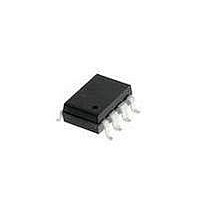HCPL-4506-520E Avago Technologies US Inc., HCPL-4506-520E Datasheet - Page 21

HCPL-4506-520E
Manufacturer Part Number
HCPL-4506-520E
Description
OPTOCOUPLER IPM 1MBD UL 8-SMD
Manufacturer
Avago Technologies US Inc.
Datasheet
1.HCPL-4506300.pdf
(21 pages)
Specifications of HCPL-4506-520E
Output Type
Open Collector
Package / Case
8-SMD Gull Wing
Voltage - Isolation
5000Vrms
Number Of Channels
1, Unidirectional
Current - Output / Channel
15mA
Data Rate
1MBd
Propagation Delay High - Low @ If
200ns @ 10mA
Current - Dc Forward (if)
25mA
Input Type
DC
Mounting Type
Surface Mount, Gull Wing
Logic Gate Type
Power Module and Gate Drive Interface Optocouplers
Configuration
1 Channel
Isolation Voltage
3750 Vrms
Current Transfer Ratio
90 %
Maximum Propagation Delay Time
650 ns
Maximum Forward Diode Voltage
1.8 V
Maximum Reverse Diode Voltage
5 V
Maximum Forward Diode Current
20 mA
Maximum Continuous Output Current
15 mA
Maximum Power Dissipation
145 mW
Maximum Operating Temperature
+ 100 C
Minimum Operating Temperature
- 40 C
Lead Free Status / RoHS Status
Lead free / RoHS Compliant
Available stocks
Company
Part Number
Manufacturer
Quantity
Price
Company:
Part Number:
HCPL-4506-520E
Manufacturer:
AVAGO
Quantity:
15 000
IPM Dead Time and Propagation Delay Specifications
The HCPL-4506 series include a Propagation Delay Differ-
ence specification intended to help designers minimize
“dead time” in their power inverter designs. Dead time is
the time period during which both the high and low side
power transistors (Q1 and Q2 in Figure 24) are off. Any
overlap in Q1 and Q2 conduction will result in large cur-
rents flowing through the power devices between the
high and low voltage motor rails.
To minimize dead time the designer must consider the
propagation delay characteristics of the optocoupler
as well as the characteristics of the IPM IGBT gate drive
circuit. Considering only the delay characteristics of the
optocoupler (the characteristics of the IPM IGBT gate
drive circuit can be analyzed in the same way) it is impor-
tant to know the minimum and maximum turn-on (t
and turn-off (t
erably over the desired operating temperature range.
The limiting case of zero dead time occurs when the in-
put to Q1 turns off at the same time that the input to
Q2 turns on. This case determines the minimum de-
lay between LED1 turn-off and LED2 turn-on, which
is related to the worst case optocoupler propagation
delay waveforms, as shown in Figure 25. A minimum
dead time of zero is achieved in Figure 25 when the
signal to turn on LED2 is delayed by (t
min
For product information and a complete list of distributors, please go to our website:
Avago, Avago Technologies, and the A logo are trademarks of Avago Technologies Limited in the United States and other countries.
Data subject to change. Copyright © 2005-2008 Avago Technologies Limited. All rights reserved. Obsoletes AV01-0551EN
AV02-1360EN - June 20, 2008
) from the LED1 turn off. Note that the propagation
PLH
) propagation delay specifications, pref-
PLH max
- t
PHL
PHL
www.avagotech.com
)
delays used to calculate PDD are taken at equal tem-
peratures since the optocouplers under consideration
are typically mounted in close proximity to each other.
(Specifically, t
tion are not the same as the t
full operating temperature range, specified in the data
sheet.) This delay is the maximum value for the propaga-
tion delay difference specification which is specified at
450 ns for the HCPL-4506 series over an operating tem-
perature range of -40°C to 100°C.
Delaying the LED signal by the maximum propagation
delay difference ensures that the minimum dead time
is zero, but it does not tell a designer what the maxi-
mum dead time will be. The maximum dead time oc-
curs in the highly unlikely case where one optocoupler
with the fastest t
are in the same inverter leg. The maximum dead
time in this case becomes the sum of the spread
in the t
The maximum dead time is also equivalent to the differ-
ence between the maximum and minimum propagation
delay difference specifications. The maximum dead time
(due to the optocouplers) for the HCPL-4506 series is
600 ns (= 450 ns - (-150 ns) ) over an operating tempera-
ture range of -40°C to 100°C.
PLH
and t
PLH max
PHL
propagation delays as shown in Figure 26.
PLH
and t
and another with the slowest t
PHL min
PLH max
in the previous equa-
and t
PHL min
, over the
PHL






